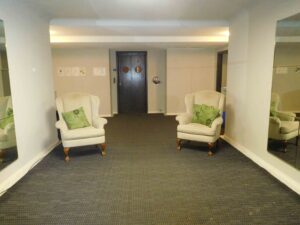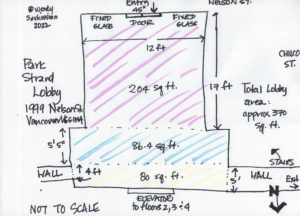What can one woman do?
… when a woman knows she is to be hanged in a fortnight,
it concentrates her mind wonderfully.
After Samuel Johnson
Climatically, things are not well. The weather is crazy. The coldest Spring on record. Too cold to sit outside – in mid-May! The wettest summer on record is now predicted. And today, a derecho event, a long-lived, fast-moving thunderstorm, caused widespread wind damage in Ontario. Like a tornado. Climate change again!
My being trembles with despair.
When I was a young activist, we chanted Think global, act local. On principle, we agitated to prevent climate change’s negative impacts. Now I am reduced to adaptation. Does that matter? Will my small contribution be enough?
I reflect on the Before Time. In my working life I imagined myself as a bridge or a weaver. I combined community development and technical solutions. Making public housing safer for women. Or applying ecological design principles to parks and playgrounds while still making them fun for kids and restful for older people. I had a full life. I loved the interplay, the spaces in-between. But that work ended six years ago and I’ve faced some big challenges since then. Not the least was rebuilding my cognitive abilities and my confidence.
I’m surfing on my phone, aware that despair, my evil twin, is stalking me. Weather forecasters predict the return of the extreme heat emergency that struck British Columbia a year ago. Anthropogenic climate change. We brought this on ourselves!
I stop to breathe. My friends say I sound stressed. Yep. The Earth is dying and I feel guilty.
This bloody heat dome. Poor, vulnerable, old people bore the brunt of it last year. It’s always that way: climate change hits the poor hardest. In less than a week, 619 people died here, most from heat stroke and heat exhaustion: nearly a 200% increase. Many had mental illnesses and depress. Most were older and lived alone.
How could anyone let this happen? We know better. A few simple things might have saved all those people. And the problem wasn’t the heat. Many people are just plain ignorant about how to manage it. I didn’t struggle much. I had one bad night, similar to the hundreds I’d had in Australia. I used the old Aussie trick. Put a large beach towel on my bed. Soaked a towel, wrung it out. Aimed my fan at the bed and lay down with the wet towel on top of me. I slept for several hours.
Basically, ignorance killed many lonely, isolated older people. They lived alone in rental apartments in older buildings without air conditioning. The unlucky ones lived on upper floors with poorly insulated roofs. Some also suffered from anxiety and depression.
So, what happened with our emergency services, I hear you ask? Swamped! Completely swamped by emergency calls. The emergency services collapsed. Totally! They sent taxis to collect sick people. A fire inspector told me about one desperate family who pushed their grandfather in a wheelbarrow to the local fire station. He died of heat stroke en route.
I turn back to my phone. I must do something.
On the Web I find two clever suggestions from the City of Vancouver: (1) turn apartment lobbies and lounges into temporary cool rooms for older or vulnerable tenants; and (2) install sprinklers and portable misting outside building entrances. Excellent! I’ll start with the cool room idea. I live in an un-airconditioned 1947 concrete building. Perfect! I bet my neighbours won’t schlepp four blocks to our only cooling centre. Anyway, the City advises we should not go out to seek relief during a heat alert.


I’m reading Joanna Macy’s new book: Active Hope. It’s a practice, like Tai chi or gardening and we can apply its three simple steps in any situation:
(1) We take a clear view of reality;
(2) We find the direction we’d like things to move in or the values we’d like to see expressed; and
(3) We take steps to move ourselves or our situation in that direction.
Following this wise guidance, I get to work.
I don’t think my fragile neighbours would go to the cooling centre three blocks away. Older people can be funny old birds. I bet some will feel shy or hesitant about showing up at a cooling centre even if they knew what and where they were. I imagine one old person saying something like this:
What should I expect at the cooling centre? What should I wear? What do I need to bring? Do I need special permission to get in? How long can I stay? Do I have to pay? Do I need to prove I live nearby? Do they have bathrooms there? Will I be safe with so many strangers around? Can I sleep there? What about my purse, my medicines, my dentures, my walker, my cane? Can I bring my cat?”
My view, my values and my steps. Here I go. I decide the secret is to stay home and help each other. Care for each other. Soon I’m dreaming in Technicolor: a cool room for our 65 tenants with a misting spray outside the front door. Chris and I measure the spacious lobby: 370 square feet. I send the floor plan to the fire inspector, a spirited young woman with dark, sparking eyes. She visits and gives my temporary cool room an enthusiastic thumbs up. Her senior officers love the idea, too.
A dozen more chairs will be fine. She’ll make a sign with the permitted occupancy level that we can post. We have a large industrial fan and deck chairs on our rooftop. No problems with fire exits because we have five ground-floor exits. And to cool us down more, we can stand under a patio misting system outside our front door. (Cost: $28, delivered.)
I’m dreaming in Surround Sound now, imagining a bunch of us old folks sitting around, chatting, laughing supporting each other, and sharing. Sharing, well pretty much anything: cold drinks, pizza, games… I’ve a music system and a cooler. We are sitting together, sharing our fears about what’s happening with our erratic weather. We have music. The room sparkles with laughter. We wander in and out of the cool misting spray.
My building superintendent is a gem who eagerly supports the idea. He nods, gives me his laconic grin, and I know we can pull this off together. Head office must decide, of course, he says. So, I email the downtown property manager. He refuses. Point blank. He spoke to his insurer. My cool room much too high-risk to even think about. Homeless people could wander in and hurt us, he says. Tenants congregating in our lobby could be trampled to death by their neighbours racing to the main door to escape a fire. (We have five ground-floor exits.) Such a gathering of hot bodies could become a COVID super-spreader event among my most vulnerable neighbours. And worst of all: “What if someone dies seeking refuge in our cool room? Our company would be responsible.”
Later he writes, “We are not a cooling centre.”
If I had a dollar for every risk-averse manager I’ve encountered in 50 years as a planner…
But I keep trying. I craft a list of simple “stay cool” guidelines for tenants. Like putting ice on your pulse points, setting up a cross-breeze, freezing a damp towel. If one person who reads them escapes a lonely, terrifying death, I’ll feel vindicated.
I email a few pages of my tips to the downtown property manager, who quickly replies:
I want to be clear that we are not authorizing you to share your draft notice with our tenants on our behalf and we don’t intend on consulting you further regarding our notice. Please be advised that this company will not be taking a leadership role in any public health measures or recommendations for our tenants, as doing so would be highly inappropriate and irresponsible on our part. We are not public health officials nor do we profess to have any expertise in the area. We are property managers.
What to do? Then I have an uncomfortable conversation with myself. Where am I coming from? Where does my hesitancy originate? Why do I fear that my climate change activism is not good enough? I remember my career as a community planner. Who cares about writing a few guidelines or encouraging a dozen overheated tenants to sit in a cool room for a few hours? That is not real work! Not real activism.
Blessedly, Rumi’s wise words interrupt my orgy of self-abnegation:
This talk is like stamping new coins. They pile up,
while the real work is being done outside
by someone digging in the ground.
Of course, the real work of climate change is not talk. It’s action, however humble. Hopeful action. It’s about care, about digging in the ground of our lives: community. Sure, I face limits. And I must set my sights high. I must regain my hope. I must show up. I am a climate activist so I must turn my back on fear and embrace active hope.
And when I look inside my heart, hope is exactly what I find.
I email Diane at my activist church. Of course, those wise, gentle people agree to distribute my “stay cool” guidelines to a congregation overflowing with older folk. I can talk about them at the next meeting. Next stop: Angela at the Red Cross. Their “Friendly Calls” program will distribute them to isolated people. And Susan at the West End Seniors Network. They will publish my guidelines in their next newsletter. Only three phone calls! I can go much deeper, much further… The editor of an activist weekly is eager to talk about cool rooms.
Before I can catch my breath, CBC radio takes up the issue. I do two radio interviews about the cool room idea. Vancouver Coastal Health and Fraser Health issue a bulletin to landlords and strata managers asking them to relax regulations to permit cool rooms in building lobbies. My Aussie friends chime in sympathetically, explaining how to stay cool in a hot place. Soon LinkedIn, Facebook, and Twitter are buzzing about cool rooms and “stay cool” guidelines.
Then I’m on CBC radio:
https://www.cbc.ca/listen/live-radio/1-46-on-the-coast
Maybe we will save lives, after all. I know one thing: to make a difference in our climate crises, we must understand what caring feels like.
I leave my desk and walk over to my living room window. A vertical curtain of raindrops shimmers. I open the window and breathe in the damp air. Below me, my city sleeps.
I breathe in hope.
And hope breathes me.